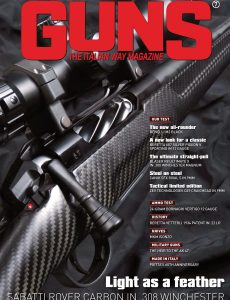
GUNS The Italian Way – Issue 7 – May 2023
English | 88 pages | pdf | 38.99 MB
Evil is not the weapon, but the woodworm of the user
The Bureau of alcohol, tobacco, firearms and explosives published the National firearms commerce and trafficking assessment (Nfcta), a report that addresses issues related to the legal trade and illegal trafficking of firearms in the United States.
In the document, there are interesting informations on the volumes of arms production and on the trends of the North American market in the period between 2000 and 2020. In these twenty years, the total number of arms produced by US companies for every 100,000 inhabitants has increased from 1,397 to 3,410. In the five years between 2016 and 2020, US companies produced more than 33 million handguns; of these, three companies in particular (Smith & Wesson, Sig Sauer and Ruger) produced two-thirds of the total in calibers up to and including 9mm. The number of handguns produced has numerically exceeded that of long guns, becoming the most important production category. According to the ATF, this driving effect was determined by the approval, in many states of the Union, of regulations that allow personal defense concealed carry.
Also interesting is the data related to type 07 federal licenses (the one that allows you to buy, sell, repair and produce firearms and ammunition): in 2000, for example, the state with the highest number of licenses of this type was California with 7.7%, while in 2020 California dropped to sixth place with 3.8%. In contrast, Texas, which in 2000 was in second place with 7.2%, currently finds itself in first place with 12.3%.
In Italy as in the United States and in many other countries, including European ones, the equation with more weapons in circulation and more risks for citizens is the one that wins hands down, even if it often contradicts reality and numbers. In this sense, I was pleased to read the reflection of Marcello Veneziani, journalist, writer, intellectual very close to the political area of the Italian conservatories. In his article entitled “The demon who inspires senseless massacres”, he analyzes the phenomenon of mass shooting in the United States without demagoguery. I took the liberty of making a collage with what I consider to be the most significant passages of Veneziani’s reflection, which are also the ones in which I identify. “In the first part of the year we are living, there have been 22 massacres with 115 victims. Last year the record for mass shootings was reached with 36 shooting deaths and 186 deaths overall. But less than halfway through this year we are already almost two-thirds of last year, with the likelihood of surpassing that record. What is creepy about these massacres? The absence of a motive, of an impulse of anger for an argument. Everything is premeditated, planned, but also senseless, with no real motivation. What is the response that is usually suggested to this escalation? We forbid weapons, forbid their purchase and use, in a country where possession of guns is ancestral and widespread. The solution is as simplistic and hasty as it is unreal and impracticable, because people consider guns as a necessary equipment to defend their lives, freedom, security, property.
A broader, cultural and social, anthropological and sociological analysis of the phenomenon is lacking. The massacres are not an archaic legacy of old America. They grow with the growth of loneliness and the virtual world, they grow with the pathologies of narcissism and self-centeredness. The impulses that lead to the massacre can be reduced to a few factors: the social predisposition to war and to violence as the solution to every difficulty, to every conflict.
The showdown, the nature of a country that feels itself to be the gendarme of the world and of an individualistic matrix, is translated into the daily, private, interpersonal dimension; the multi-ethnic composition of American society, the absence of a common world, of traditions and cultures of origin, as a condition that produces a society of distrustful atoms, with noncommunicating languages, in permanent conflict; and here the third reason is triggered, which is perhaps the main one: loneliness, uprooting, the inability to cultivate social relationships, to live immersed in a society in which the artificial and the virtual increasingly take the place of the natural and real, in which the boundaries between fiction and authenticity, the real world and the playful and fictitious universe of the web are lost. The solution of abolishing guns is usually combined with an ideological discourse that takes its cue from some obsessed with radical ideologies and ethnic hatreds to argue that this is the main reason for the massacres. But those ideologies, those slogans, those images act only as icons, as symbolic frames to give a name and a sign to violence. We know that many massacres arise from opposing ideological reasons, but also from resentful
migrants who hate the society in which they feel alienated and use religious reasons and ethnic revenge to justify their violence.
Also in this case the fault is not of their ideas or ethnicity, but of the destructive drive that makes use of those alibis. It is also possible to prohibit or limit the abuse of guns, perhaps it is useful, but it is not sufficient. The problem is more radical and more difficult to solve. Evil is not the weapon in the house, but the worm in the head of whoever uses it”.
Giulio Orlandini
Editor
Download from: